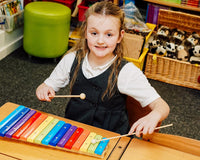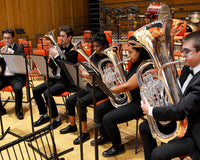There is a huge variety of different terms linked to the woodwind instruments. This can be very frustrating at times, especially when you are looking for your first instrument. We have compiled the most common terms to guide you through the basics of the woodwind family.
Parts of instruments
Recorder – head joint, main joint and foot joint
Flute – head joint, barrel, joints, foot joint
Oboe – upper joint, lower joint, bell
Clarinet – mouthpiece, barrel, joints, bell
Bassoon – wing joint, butt joint, bass joint, bell
Saxophone – mouthpiece, tube, bow, bell
Single Reed (Clarinet/Saxophone) – the single reed vibrates against the mouthpiece to produce sound. The reed on these instruments is held down by a ligature.
Double Reed (Oboe/Bassoon) – as the name suggests, these instruments use two reeds that are tied together to make a sound.
Transverse (Flute) – works by blowing air across a hole, similar to blowing across a bottle.
Whistle (Recorder) – very similar to a transverse flute, but, instead of a blowhole the air is blown directly into the end of the instrument.
Barrel - the section of a woodwind instrument located between the mouthpiece, head joint and the main section. In this location, there is a section that allows the musician to adjust their tuning.
Bell – vital for good sound projection and tone. Bell is the bottom section of woodwind instruments.
Joints - individual sections of woodwind where the main keywork is usually located.
Flap - part of the key which covers the sound hole. Flaps usually feature leather padding, cork or cloth to make them air-tight.
Reed – a piece of wood (usually bamboo) used to play woodwinds. It causes vibrations by blowing through in order to make a sound.
Spring – these are usually metal and ensure that the key is returned to its original position after being pressed down. Springs can either be attached to the body of the instrument or the keys themselves.
Materials – the body of woodwinds can be made of a variety of materials that can affect their tone, durability and portability.
ABS Resin/Ebonite (hard rubber) – often used in recorders and cheaper range/student instruments such as beginner clarinets, oboes and bassoons. Also, perfect for outdoor use as rubber is more resistant to weather conditions.
Metal – commonly used to manufacture flutes using alloy of nickel for cheaper flutes and silver-plated metal for the more expensive models.
African Blackwood (Grenadilla) and other woods such as rosewood are used to create clarinets and oboes.
Maple – sycamore or sugar maple are broadly used to create bassoons.
Brass – commonly used in saxophones and is usually lacquered or silver plated. Lacquer can also be in a variety of colours.
Plastic – used in recorders, student oboes and clarinets. Although this is a cheaper material, similar to ABS resin, it is also perfect for outdoor events or travelling.















